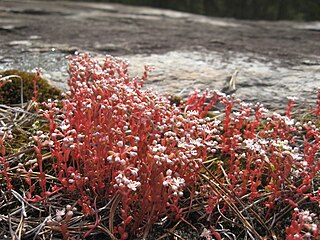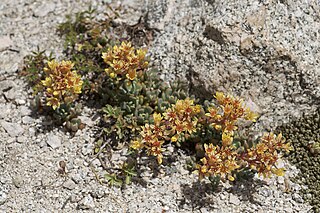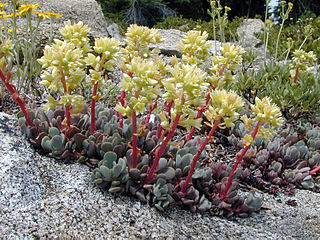
The Crassulaceae, also known as the stonecrop family or the orpine family, are a diverse family of dicotyledon flowering plants characterized by succulent leaves and a form of photosynthesis, known as Crassulacean acid metabolism (CAM). Flowers generally have five floral parts. Crassulaceae are usually herbaceous but there are some subshrubs, and relatively few treelike or aquatic plants. Crassulaceae are a medium-sized monophyletic family in the core eudicots, among the order Saxifragales, whose diversity has made infrafamilial classification very difficult. The family includes approximately 1,400 species and 34–35 genera, depending on the circumscription of the genus Sedum, and distributed over three subfamilies. Members of the Crassulaceae are found worldwide, but mostly in the Northern Hemisphere and southern Africa, typically in dry and/or cold areas where water may be scarce, although a few are aquatic.

Sedum is a large genus of flowering plants in the family Crassulaceae, members of which are commonly known as stonecrops. The genus has been described as containing up to 600 species, subsequently reduced to 400–500. They are leaf succulents found primarily in the Northern Hemisphere, but extending into the southern hemisphere in Africa and South America. The plants vary from annual and creeping herbs to shrubs. The plants have water-storing leaves. The flowers usually have five petals, seldom four or six. There are typically twice as many stamens as petals. Various species formerly classified as Sedum are now in the segregate genera Hylotelephium and Rhodiola.

Dudleya, commonly known as liveforevers is a genus of rosette-forming succulent plants in the stonecrop family, Crassulaceae, consisting of about 68 taxa in southwestern North America and Guadalupe Island. The species come in many forms, some large and evergreen, others geophytic and deciduous. Yet, despite their dramatic variations in appearance, most species readily hybridize. The flowers of Dudleya have parts numbered in fives, with the petals arranged in tubular, star-shaped, and bell-shaped forms and, when fruiting, are filled with tiny, ovoid-crescent-shaped seeds.

Sedum acre, commonly known as the goldmoss stonecrop, mossy stonecrop, goldmoss sedum, biting stonecrop, and wallpepper, is a perennial flowering plant in the family Crassulaceae. It is native to Europe, northern and western Asia and North Africa, but is also naturalised in North America, Japan, and New Zealand.

Petrosedum rupestre, also known as reflexed stonecrop, Jenny's stonecrop, blue stonecrop, stone orpine, prick-madam and trip-madam, is a species of perennial succulent flowering plant in the family Crassulaceae, native to northern, central, and southern Europe.

Hylotelephium telephium, known as orpine, livelong, frog's-stomach, harping Johnny, life-everlasting, live-forever, midsummer-men, Orphan John, witch's moneybags, and garden stonecrop is a succulent perennial plant of the family Crassulaceae native to Eurasia. The flowers are held in dense heads and can be reddish or yellowish-white. A number of cultivars, often with purplish leaves, are grown in gardens as well as hybrids between this species and the related Hylotelephium spectabile (iceplant), especially the popular 'Herbstfreude'. Occasionally garden plants may escape and naturalise as has happened in parts of North America.

Rhodiola is a genus of perennial plants in the family Crassulaceae that resemble Sedum and other members of the family. Like sedums, Rhodiola species are often called stonecrops. Some authors merge Rhodiola into Sedum.

Draba verna, common whitlowgrass, is a species of plant in the cabbage family. It is a small spring-flowering annual which is widely dispersed around the world, and which is found on walls, pavements and patches of bare ground. It has a complex taxonomy which is not yet fully elucidated.

Sedum smallii, synonym Diamorpha smallii, is a species of plants in the family Crassulaceae. It is known as elf orpine and Small's stonecrop. As Diamorpha smallii it was considered to be the only species in the genus Diamorpha.

Hylotelephium is a genus of flowering plants in the stonecrop family Crassulaceae. It includes about 33 species distributed in Asia, Europe, and North America.

Sedella is a small genus of annual flowering plants in the family Crassulaceae. There are approximately 7 species, all native to California, United States, one with a distribution extending into Oregon. These are petite succulent plants growing a few centimeters tall and bearing tiny yellowish or brownish flowers. Mock stonecrop is a common name for these plants.

Sedum lanceolatum is a species of flowering plant in the stonecrop family known by the common names lanceleaf stonecrop and spearleaf stonecrop.
Sedum oblanceolatum is a species of flowering plant in the family Crassulaceae known by the common names oblongleaf stonecrop and Applegate stonecrop. It is native to the Klamath Mountains of southwestern Oregon and far northern California, where it grows on many types of rocky substrate, such as serpentine soils and other ultramafics. It is a succulent plant forming basal rosettes of waxy leaves. The leaves are mainly lance-shaped, widest near the distal end and narrowing to rounded or notched tips. Smaller leaves occur higher up the stem. The small inflorescence grows a few centimeters tall and bears up to 50 flowers in a flat-topped array. The flowers have cream or yellowish petals up to a centimeter long.

Sedum obtusatum is a species of flowering plant in the family Crassulaceae known by the common name Sierra stonecrop. It is native to the Sierra Nevada and adjacent high mountain ranges of California, its distribution extending north into Oregon and east into Nevada. It grows in rocky mountain habitat.

Sedum oregonense is a species of flowering plant in the family Crassulaceae known by the common name cream stonecrop. It is native to the Klamath Ranges of southern Oregon and northern California, where it grows in rocky habitat. It is a succulent plant forming basal rosettes of leaves up to about 4 centimeters long. Smaller leaves occur farther up the stem. The leaves are green in color and waxy in texture. The inflorescence is an erect, wide open array of many flowers. The flowers have yellow petals with red-tinged or white-speckled undersides.

Sedum spathulifolium is a species of flowering plant in the family Crassulaceae known by the common names broadleaf stonecrop, yellow stonecrop, and spoon-leaved stonecrop. An evergreen perennial, it is native to western North America from British Columbia to southern California, where it can be found often in shade in many types of rocky habitat in coastal and inland hills and mountains.

Sedum stenopetalum, also known as wormleaf stonecrop or narrow-petaled stonecrop, is a species of flowering plant in the stonecrop family. It is native to western North America from British Columbia and Alberta to northern California to Wyoming. It can be found in many types of rocky habitat, such as cliffs, talus, and steep ridges. It is a succulent plant producing mats or clumps of lance-shaped, linear, or three-lobed leaves each under 2 centimeters long. The inflorescence is a short, erect array of one to many flowers with lance-shaped petals up to a centimeter long. The petals are yellow, sometimes with red veins.

Sedum sarmentosum, known as stringy stonecrop, gold moss stonecrop, and graveyard moss, is a perennial flowering plant in the family Crassulaceae native to East Asia and Southeast Asia (Thailand). It has been introduced in at least eastern North America, and Europe.

Sempervivoideae is the largest of three subfamilies in the Saxifragales family Crassulaceae, with about 20–30 genera with succulent leaves. Unlike the two smaller subfamilies, it is distributed in temperate climates. The largest genus in this subfamily is Sedum, with about 470 species.

Sedum nevii, or Nevius' stonecrop, is a species of flowering plant in the family Crassulaceae. It is native to the US states of Tennessee, Alabama, and Georgia, at elevations around 1,000 m (3,300 ft). A decumbent perennial reaching 10 cm (4 in), it is usually found growing on top of mosses and lichens, themselves growing on rocky crevices, ledges, and even talus typically composed of quartzite and gneiss. Among other characters, it can be distinguished from its congeners by its red anthers, and by the pronounced lips of the adaxial suture of its follicles.


















